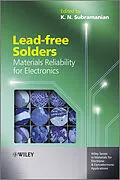Providing a viable alternative to lead-based solders is a major research thrust for the electrical and electronics industries - whilst mechanically compliant lead-based solders have been widely used in the electronic interconnects, the risks to human health and to the environment are too great to allow continued widescale usage. Lead-free Solders: Materials Reliability for Electronics chronicles the search for reliable drop-in lead-free alternatives and covers:
* Phase diagrams and alloy development
* Effect of minor alloying additions
* Composite approaches including nanoscale reinforcements
* Mechanical issues affecting reliability
* Reliability under impact loading
* Thermomechanical fatigue
* Chemical issues affecting reliability
* Whisker growth
* Electromigration
* Thermomigration
Presenting a comprehensive understanding of the current state of lead-free electronic interconnects research, this book approaches the ongoing research from fundamental, applied and manufacturing perspectives to provide a balanced view of the progress made and the requirements which still have to be met.
Autorentext
K. N. Subramanian is Professor of Materials Science and Engineering at Michigan State University. He has been a full-time faculty member at MSU for over 45 years. For the last 15 years he has devoted all his research efforts to lead-free electronic solders.
Inhalt
Series Preface xv
Preface xvii
List of Contributors xix
Thematic Area I: Introduction 1
1 Reliability of Lead-Free Electronic Solder Interconnects: Roles of Material and Service Parameters 3
K. N. Subramanian
1.1 Material Design for Reliable Lead-Free Electronic Solders Joints 3
1.2 Imposed Fields and the Solder Joint Responses that Affect Their Reliability 5
1.3 Mechanical Integrity 5
1.4 Thermomechanical Fatigue (TMF) 6
1.5 Whisker Growth 7
1.6 Electromigration (EM) 7
1.7 Thermomigration (TM) 8
1.8 Other Potential Issues 8
Thematic Area II: Phase Diagrams and Alloying Concepts 11
2 Phase Diagrams and Their Applications in Pb-Free Soldering 13
Sinn-wen Chen, Wojciech Gierlotka, Hsin-jay Wu, and Shih-kang Lin
2.1 Introduction 14
2.2 Phase Diagrams of Pb-Free Solder Systems 14
2.3 Example of Applications 23
2.4 Conclusions 39
3 Phase Diagrams and Alloy Development 45
Alan Dinsdale, Andy Watson, Ales Kroupa, Jan Vrestal, Adela Zemanova, and Pavel Broz
3.1 Introduction 45
3.2 Computational Thermodynamics as a Research Tool 48
3.3 Thermodynamic Databases the Underlying Basis of the Modelling of Phase Diagrams and Thermodynamic Properties, Databases for Lead-Free Solders 51
3.4 Application of the SOLDERS Database to Alloy Development 57
3.5 Conclusions 68
4 Interaction of Sn-based Solders with Ni(P) Substrates: Phase Equilibria and Thermochemistry 71
Clemens Schmetterer, Rajesh Ganesan, and Herbert Ipser
4.1 Introduction 72
4.2 Binary Phase Equilibria 73
4.3 Ternary Phase Equilibria Ni-P-Sn 85
4.4 Thermochemical Data 94
4.5 Relevance of the Results and Conclusion 111
Thematic Area III: Microalloying to Improve Reliability 119
5 'Effects of Minor Alloying Additions on the Properties and Reliability of Pb-Free Solders and Joints' 121
Sung K. Kang
5.1 Introduction 122
5.2 Controlling Ag3Sn Plate Formation 125
5.3 Controlling the Undercooling of Sn Solidification 132
5.4 Controlling Interfacial Reactions 136
5.5 Modifying the Microstructure of SAC 145
5.6 Improving Mechanical Properties 149
5.7 Enhancing Electromigration Resistance 151
5.8 Summary 153
6 Development and Characterization of Nano-composite Solder 161
Johan Liu, Si Chen, and Lilei Ye
6.1 Introduction 162
6.2 Nano-composite Solder Fabrication Process 162
6.3 Microstructure 166
6.4 Physical Properties 167
6.5 Mechanical Properties 169
6.6 Challenges and Solutions 171
6.7 Summary 174
Thematic Area IV: Chemical Issues Affecting Reliability 179
7 Chemical Changes for Lead-Free Soldering and Their Effect on Reliability 181
Laura J. Turbini
7.1 Introduction 181
7.2 Soldering Fluxes and Pastes 181
7.3 Cleaning 185
7.4 Laminates 185
7.5 Halogen-Free Laminates 186
7.6 Conductive Anodic Filament (CAF) Formation 189
7.7 Summary 193
Thematic Area V: Mechanical Issues Affecting Reliability 195
8 Influence of Microstructure on Creep and High Strain Rate Fracture of Sn-Ag-Based Solder Joints 197
P. Kumar, Z. Huang, I. Dutta, G. Subbarayan, and R. Mahajan
8.1 Introduction 198
8.2 Coarsening Kinetics: Quantitative Analysis of Microstructural Evolution 199
8.3 Creep Behavior of Sn-Ag-Based Solders and the Effect of Aging 206
8.4 Role of Microstructure on High Strain Rate Fracture 219
8.5 Summary and Conclusions 227
9 Microstructure and Thermomechanical Behavior Pb-Free S...
